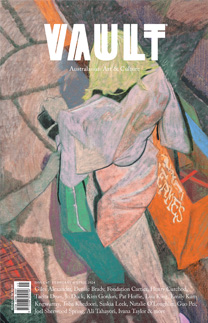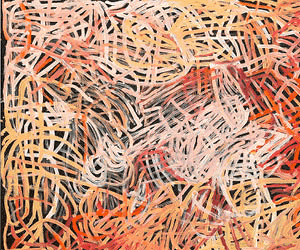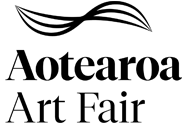Reko Rennie:
Visible Invisible
Reko Rennie deploys colour and camouflage as methods for personal and collective cultural continuum.
In 2017, Reko Rennie was commissioned by Melbourne based collectors Corbett and Yueji Lyon to create a painting on the foundation of their new Lyon Housemuseum Galleries in suburban Kew, Melbourne. Measuring 20 metres wide and 44 metres in length, the painting is Rennie’s largest work to date, requiring more than 600 litres of paint to create the artist’s signature ‘camouflage’ pattern in vibrant pink, blue and green hues.
What is perhaps most notable about
the work, though, is its temporality;
the painting was visible in its entirety for
a matter of days before construction
on the rest of the building commenced.
Only a small segment of the painting remains uncovered, viewable through
a small window in the floor of the completed building. The work, Visible Invisible (2017), reflects a hybridity that has
defined Rennie’s practice since the artist began exhibiting just over a decade ago: visible and invisible, public and private, urban and traditional. The tesion present in these binaries are aspects of the artist’s ongoing negotiation of his identity as an Aboriginal man in contemporary Australia.
Born and raised in Melbourne’s inner west, of Kamilaroi (northern New South Wales) ancestry, Rennie has no formal art training; instead he became involved in the city’s thriving graffiti scene as a teenager.
The artist felt energised by graffiti’s potential to “be seen by the masses, give voice and integrity to its creators, and be part of broader conversations”.1 Hip-hop music and urban culture were also formative influences on Rennie’s work, reflected in his fluorescent colour palette and imagery .. Subscribe to read this article in full

























